Darren Gross Interviews
Helen Samuels,
the "star" of the
Legendary Deleted Massacre
of Sam Peckinpah's Major Dundee
DVD Savant Interview
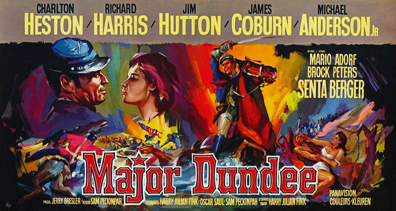
Introduction by Glenn Erickson:
For almost fifty years, the official line on Sam Peckinpah's Major Dundee has been that his scripted opening massacre scene was never filmed. In short, the story goes that Columbia radically shortened the film's shooting schedule just before filming began, and shut the production down early. Charlton Heston famously gave back his salary as a trade to get the studio to let Peckinpah continue directing. Columbia reportedly took the money and pulled the plug anyway. In his book on westerns Horizons West, Jim Kitses' reported that the massacre scenes were scheduled to be filmed last, and as a consequence were not filmed at all. That judgment does not seem to be true, at least, not entirely.
I had my doubts as early as 1979, after I purchased a photo picturing a scene clearly taken during the filming of the "non-existent" massacre sequence.
Peckinpah's epic movie was originally meant to begin with a pre-title prologue that might have been ten or fifteen minutes in length. In the final film a narration tells us that a Company of Union Cavalry "was ambushed and massacred at the Rostes Ranch", but all we see is a faint image of men riding up a hill, followed by morning-after scenes of the victorious Indians riding off with their spoils, including a pair of now-orphaned boy captives.
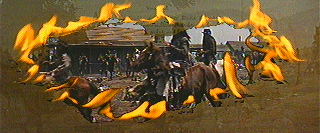
As scripted, a boistrous Halloween party takes place at the Ranch on the night before. Just in script form, the scene has been singled out as brilliant and used for study in screenwriting courses. Among other characters and subplots now lost (and later missed when follow-up scenes mention them) we see a brief flirtation between a young Bugler, Tim Ryan (popular teen star Michael Anderson Jr.) and the rancher's teenage daughter, Beth Rostes. She's dressed as a ghost, in a white sheet. After they watch other kids dressed as ghosts and Apaches running about, Tim chases her a bit as well, and gets his first kiss.
Tim finds Beth, corners her near the barn.
Tim: (after a moment) Can I kiss you?
Beth: Why?
Tim looks at her; he's got a thousand reasons and can't think of one. Beth smiles, steps up and kisses him gently, then overcome by her boldness, runs off, TIM following as...
Almost immediately the Apache attack. At first, both the drunken troopers and the audience can't tell the attackers apart from the kids made up with bright war paint. Tim is the only adult to escape. When we last see Beth, she's in a bad way:
An angle: OF TIM
Starting across the yard on horseback, slowing.
OF THE ROSTES GIRL
As she reaches her arms for him and falls, stitched with arrows.
Film fans and especially Sam Peckinpah fans have lamented the loss of this prologue, which would have launched Major Dundee in fine, original form as a western epic.
Thanks to the efforts of Darren Gross, we know now that at least some of it was actually filmed.
Darren Gross has been researching films for years. He is presently a Technical Services Coordinator at Deluxe, working on the MGM film library. One of his specialties has been finding missing film elements and versions, at which he's had more than a little success. He's found and done restoration work on a longer version of Night of Dark Shadows. His biggest coup was locating the notorious cut scenes for David Lynch's Blue Velvet. Lynch had been looking for the errant footage for twenty years.
This time Darren wanted to find out if the Dundee Massacre Prologue had been filmed. He was inspired by the photo I had bought, showing actor Michael Anderson Jr. on an exterior set with a smiling blonde girl. Darren found out who the actress was and found a way to contact her. His interview with her is presented here for the first time.
The lady's name is Helen Samuels. She was never credited with her role in Major Dundee. Here is her story. -- Glenn Erickson
Darren Gross Interviews Helen Samuels,
the "star" of the Legendary Deleted Massacre
of Sam Peckinpah's Major Dundee
Darren Gross: How were you cast in Major Dundee?
Helen Samuels: I was living in Mexico, and my dad (Robert Samuels) was doing script doctoring and several other things. He'd directed some things in Mexico for TV stations down there. I was actually working as a reporter for the Mexican newspaper Excelsior, but I loved acting. Lonka Becker (the Mexican casting director for Major Dundee) contacted my dad and said there's a big production in town, Sam Peckinpah was directing, and they needed someone who was exactly what I was -- a cute little blonde type.
Darren: Did you meet Peckinpah or were you cast solely by Lonka Becker?
Helen: Lonka Becker cast me, but Peckinpah met me. When I met Peckinpah, it was in Mexico. Everything was done in Mexico. He was very specific about talking to me in person and it was fun -- he was very to the point, and he liked me. I did have to read for him personally -- I think he was concerned that since I lived in Mexico that I may have had a heavy accent. I remember when he approved me for the film, he was in Becker's office and I was as happy as can be, and he was just charming.
He made some accommodations for me, because they were discussing wardrobe and they were trying to put me in pink, and I hated pink. I felt like a pink shrimp, so he changed it to blue. He was very kind about that and I met some of the other people in production at that time. I still have a shot of me posing on set in my blue dress and the silly hairdo they gave me that I hated. (laughs)

Darren: How long was it between when you were cast and when filming began?
Helen: It wasn't too long. I think I was cast a few months before shooting. I don't remember it being too long between being cast and shooting, I remember it as a whirlwind of stuff going on.
Darren: When did you film your scenes? For how many days?
Helen: As I recall, I shot one day. We took the trip out to where my scenes were shot for only one day. I remember the location was about an hour away, but I'm not 100% sure about that. There wasn't any studio filming, it was all on location, way out in the forests near Marquesas. We took buses out there, and they had craft services out there, all the way in the boonies. There were very few women on-set as I recall, so I was allowed a few small privileges but I was allowed to use the cleaner latrine section that was set up for the stars.
I actually spent my birthday (which is April 29th) on-set. It was great to have a little cake and celebration and stuff. It was a fun experience for me because I had been doing small little plays and things, and this was like a "big American production" and Sam Peckinpah, and all that, so it was really fun.
It was a huge setup. There were tons of people there on-set. I even met Charlton Heston. I thought (the filming of my scenes) was something he wasn't going to be involved in, but I even met him. He was very polite, very much a big star persona. I know that the stars had their own tent and stuff, but he walked over, was polite, and as it was my birthday, and sang Happy Birthday to me, with everyone else.
Darren: Did you befriend anyone on set? Who did you hang around with?
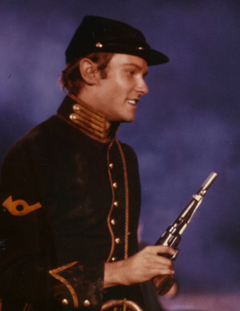
Helen: I remember Michael Anderson Jr. a lot. Michael and I hung out together for several days. I was showing him Mexico from the young person's point of view, driving around in this car, and him telling me his tales of the fun of going to a lot and buying a new car and paying it in full, in cash -- having the people who were selling the car being snooty and looking at him like, "Kid, stop bothering me," then turning around and buying the car in cash. For some reason that story stuck with me. I remember spending some time with him, but not before, but a little while after we had shot my scenes. I know after my scenes they all left for the North -- they went off to go shooting elsewhere.
Note: If true, this contradicts the information that the massacre was among the very last scenes filmed.
Darren: What was the atmosphere like on-set?
Helen: It was a little tense on set because there were tons of horses, tons of costumes, tons of Indians, tons of men dressed in blue uniforms. On-set there was lots of English and lots of Spanish being spoken, and lots of frustration because the Mexican crew wasn't helping that much. I mean they were doing some things that Peckinpah wasn't too happy about, but since it wasn't in my realm, I didn't pay too much attention to it. But because I spoke English and Spanish, I could tell there was a little bit of frustration there. I know they had to take several takes, several times -- for several things, for scenes of the horses running and the scene where I was shot with arrows in the back, etc. For that part, I had to run with a board strapped to my back and I don't know how it worked, but I was running and as I fell forward, arrows that were attached to the board popped up and it made it look as if I had been shot with arrows and that blood was coming out of my back. So they filmed me from the front running, and then from the back for the part with the arrows.
The part of my scene with the horses was done by a stuntman. Lots of men with horses were coming in and I was running to the horses when the Indians shot me with the arrows. The stuntman did that part with the horses. They put a blonde wig on him and my dress, and he went into the air when the arrows hit him. His name was Whitey, which was his nickname, if I remember. (note: probably veteran stunt man Whitey Hughes) Whitey did that shot, but I did the shot where I was face down in the mud, dead -- the one that's still in the movie. (image below)
It was a long day. It may have gone into night shooting a little bit, but not much as it got very cold at night. I remember we were up very early and it was a long, long day. My scenes were staggered throughout the day. We did a couple of scenes, then lots of waiting, then more scenes. I remember we did interior scenes (on location, not at a studio) where we were dancing, and a fiddler, I seem to remember fiddlers. In part of it, I was looking at Michael Anderson Jr. him, and he was looking at me across the room. And then we did "peekaboo" scenes where I was looking for him and he was looking for me... We did a scene where we escaped into a little barn thing, and I remember we did three takes, and I had a few words. I had a speaking part. I actually had 2 or 3 sentences or something. Then he gave me a kiss, either on the cheek or the mouth, it was a first-kiss kind of scenario and then that's when we supposedly heard the commotion and ran outside. It was my first screen kiss. I don't know if it was Michael's though. (laughs)
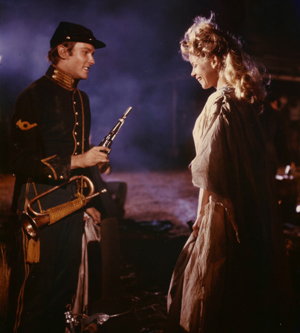
The people I remember the most were the stuntman and Michael. I had such a different lifestyle -- I wasn't your typical American girl. I had lived in a very interesting time in Mexico so I didn't gravitate to people that made too much small talk. There had to be some kind of "deep conversation" or something. (laughs) I had a passion for the human condition and why things were the way they were and what people were thinking. What amazed me were the stunts and things, so I hung out near the horsemen and the stuntmen. I like heroes, and people like stuntmen to me were impressive. I love people with a high adrenaline factor.
After doing this film, I became interested in being a stunt driver. I actually took up car racing and stuff. I can't remember what it was, but I did actually drive a jeep in something. I was attracted to that, tremendously... So, while on-set, I watched the stunts for when the Indians coming in on the horses and all the shooting and running, and fires being set on the roofs of the cabins and things. I remember there was a whole scene of the burning of the cabin, but I can't remember if they pulled it off in one day or if they had to go back to finish it. The fact that I was only there one or two days doesn't mean anything, because my scene was relatively short. Maybe they went back to finish some of it.
Now that we're talking, I seem to remember a second day. My face wasn't used to so much makeup and I may have had an allergy, as I remember my face feeling burnt, and I recall the next day trying to find creams to heal it as there was something else we were going to shoot the next day.
Darren: The script has a scene where two drunken cowboys on horses drag an outhouse to the fort wall and smash it. Do you recall filming that?
Helen: No, I don't think I remember that part...
Darren: Who directed you in your scenes, Peckinpah, or an assistant director?
Helen: I do remember Sam directing the kiss scene. I don't remember specifics about it, but I do remember he was okay with the scene.
Darren: How did you discover that your scenes were cut out?
Helen: I heard rumors that the first section was cut. But when I saw (the finished movie) I was like, "Oh, man!" because it was a great beginning. It made what came after seem a little dry. I liked the whole human part, not so much the cowboys and Indians, so I was a little disappointed. From what I remember, he (Peckinpah) wanted to set up when the Indians came, he wanted to show these poor innocent people and this young girl who was just starting her life, and they're all killed. He wanted to have a human emotional touch to it, so that there was a strong emotional reason for going after the Indians, not just hunting them for the sake of it. I feel there was much more of a story involved there.
It was so hilarious. I can't tell you how many friends I took to the movies to see it, and I warned them, "I'm not kidding -- I'm in there for 15 seconds or less at the beginning, so if you don't pay attention you're not going to see me!" (laughs) Then I'd go, "There I am!" When I first saw it, it was in Mexico, but I can't remember where or the circumstances.
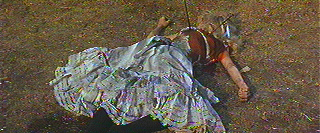
Note: This is practically all of Helen Samuels' performance that
remains in the finished film: she's in two shots, as a limp corpse.
Darren: What was your career like, post-Dundee?
Helen: I hadn't done any features at this point, but, this is crazy -- later on I ended up moving to the states and I was going to drama school and all that, and I ended up getting the contract to play The Flying Nun. I had just met the person that became my husband and, because of silly things of childhood or youth, he became extremely jealous that I had gotten this big break and I wasn't paying any attention to him. And right when we were going to the studio to do the official signing, with the press and everything, he made a big melodramatic scene and said, "You can either marry me or become this big actress." And I was profoundly in love and I made the choice that I probably wouldn't have done if I was four years older... And that was it for my career at the time, because my agent had worked so hard to get me this series, and I had already done the testing and everything, plus I spoke Spanish -- The Flying Nun was supposed to be done in Puerto Rico or something -- and I was perfect... It wasn't until afterward that they chose Sally Field, but they had chosen me first... It's one of those decisions in life. Actually, after that I ended up fulfilling my real destiny which was to be very involved in social change and stuff.
Darren: You've spent the majority of your career deeply involved in social causes and outreach to young people. Can you tell me about your current passions can concerns?
Helen: In five years we're going to have two billion people of working age and I feel that the earth is at a stage where it needs a large amount of young people dedicated to restoration. What I'm trying to do is put two and two together and create opportunities for young people, who would not otherwise be employed, by teaching them restoration skills. Ie: why be a plumber if there's no water? We're teaching dry plumbing and how to capture water and how to re-use it and how to build ecologically; how to build a community around permaculture techniques and also opening up a portal of information for young people who want careers in restoration. Restoration is already a trillion dollar business but it's not filtering down to new careers. My dream is to really make an impact worldwide, in the lives of youth from the 1st, 2nd, 3rd, or 4th world communities. So, we're offering all kinds of tools to young people, on the internet, with courses on restoration training, all the way from how-to skills, for real poverty stricken people, where a few techniques can make their lives much, much better, to high-level careers like wind farms and entrepreneurial restoration, etc. My focus right now is to create a massive network and offer to youth possibilities to choose from in restoration.
Darren: When you say restoration, do you mean ecological restoration?
Helen: Social and ecological restoration. For example, ecological restoration would be the actual restoring of the relationship humanity has with the earth, and would be things like restoring rivers, etc. but it's also about restoring humanity. We teach conflict resolution, healing, well-being as a mindset, rather than destruction as a mindset. We teach a wide gamut from restoring humanity, the community as well as the world around you.
Text © Copyright 2013 Darren Gross.
This interview was originally conducted in 2006. Since then Helen Samuels has continued her noble and conscientious work in youth leadership and global ecological and economic concerns for Tekio, now called Eko-Habitat. We thank her for generously sharing her time with us, and her memories of Major Dundee. -- Darren Gross
Savant Closing Note: Other sources still conflict with some of Helen's memories. She says that she filmed at most one or two days, which aligns with Charlton Heston's published diary. The day Ms. Samuels had a birthday on the set, is the same day that Heston left for Los Angeles. But we do know that the plug was pulled on the shooting right after Heston left. Another very reliable source says that the kissing scene and the dance scene were definitely not filmed.
How can these contrasting accounts be reconciled? Perhaps some of the actress's memories blur rehearsals with shoots. She barely recalls details like fiddlers, so maybe some of the actions she remembers weren't actually filmed. Still, the photo of Anderson and Samuels together in a night exterior has a boom microphone in it, down near their feet. Does that indicate that they were indeed in a real filming situation, or was the sound recordist rehearsing his movements as well?
-- Glenn Erickson, with help from Darren Gross and correspondent Dick Dinman.
The DVD Savant review for the new Blu-ray of Major Dundee is viewable, here.
Posted: April 20, 2013
Text © Copyright 2013 Darren Gross
DVD Savant Text © Copyright 2013 Glenn Erickson
See more exclusive reviews on the Savant Main Page.
Reviews on the Savant main site have additional credits information and are often updated and annotated with footnotes, reader input and graphics.
Return to Top of Page
|

